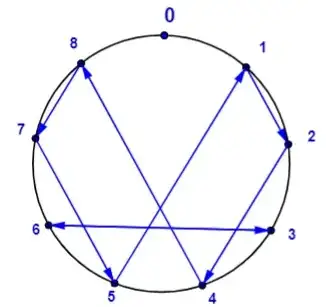So I was aimlessly scrolling on facebook and ran into a questionable post preaching the spiritual significance of the number 9. Ignoring all the philosophy and spirituality the poster basically notices the following diagram and property and claims that this is unique to the number 9 / at the least the number 9 is a very small number with this property.
So we begin by consider the power of 2s mod 9. That is
$$ 1, 2, 4, 8, 16, 32, 64 ... \mod 9$$
which by fermat's little theorem gives the repeating sequence
$$1, 2, 4, 8, 7, 5, 1, 2, 4, 8, 7, 5 .... $$
Now if you draw this sequence onto a 9-element clock (in black below), by painting a line in order of 1,2,4,8,7,5 (in violet below) and then back to 1 you get the following image:
Unfortunately I didn't draw my clock and lines correctly to scale BUT if I had it would certainly be symmetric about the center line.
So there are a couple of interesting questions you can ask about this diagram, I'm only interested in (1) for the purposes of this post but I'll include the others if they stimulate some ideas.
- Which pairs if numbers $(u,v)$ have the property that $u^n \mod v$ when traced on a v-hour clock like above end up creating an image which is symmetric about the central vertical line. I was able to notice trivially that $(0,2)$ and $(1,2)$ have this property and clearly $(2,9)$ has this property so I'm tempted to ask is $(a,b)$ where $a = 0$ or $(a,b)=1$ enough to guarantee this? Are there exotic examples which don't fall into that category?
Other thoughts:
- (Group Angle) Can an exponential sequence and clock pair $(u,v)$ ever make an image which has lines of symmetry that are NOT the center line?
a. In general if we replace the clock with a geometric representation of some arbitrary group and replace the exponential sequence with the sequence $g^n$ for some group element then what are all the possible lines of symmetry we can find via ray-tracing exponential sequences for a particular group

